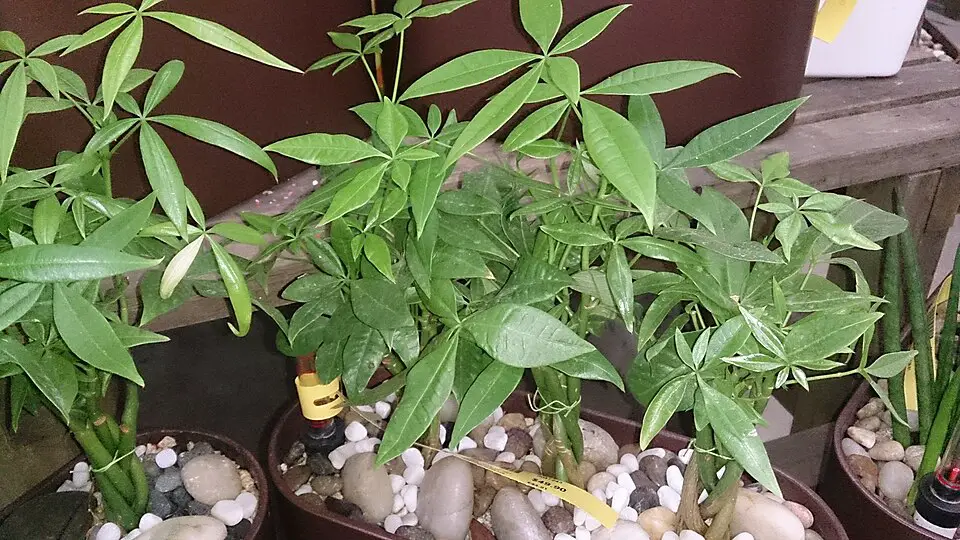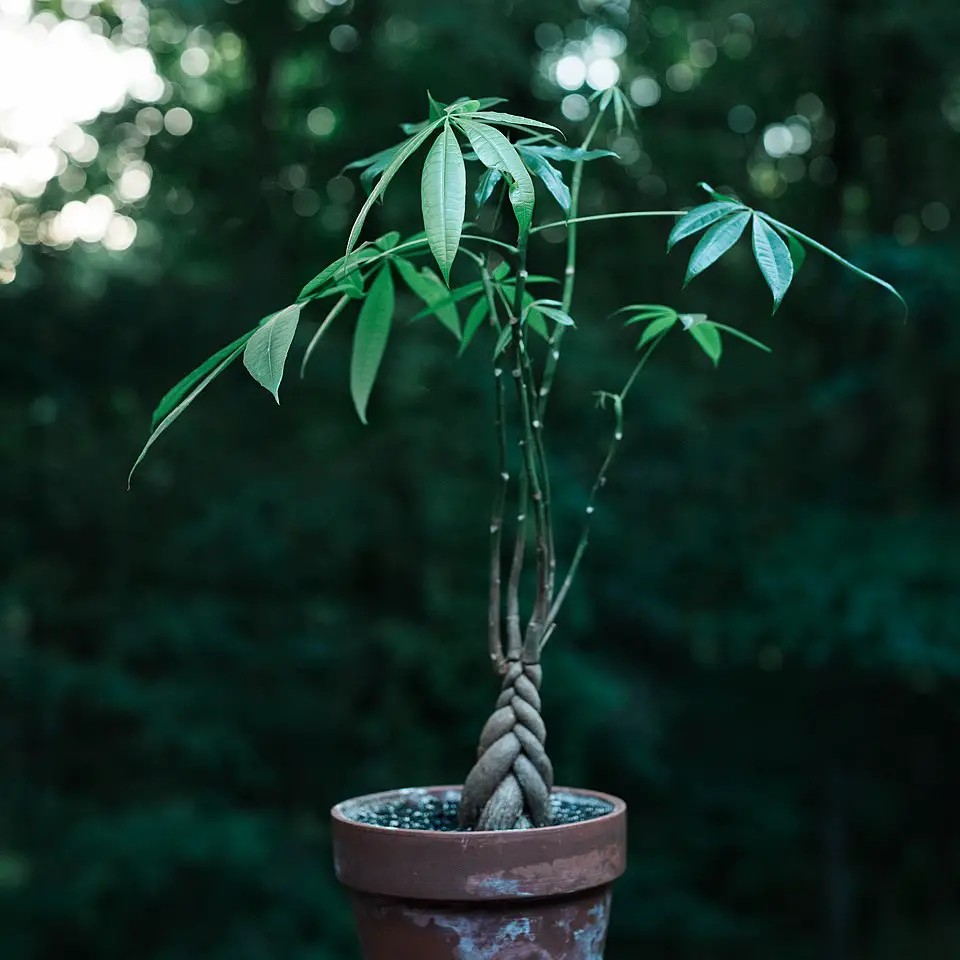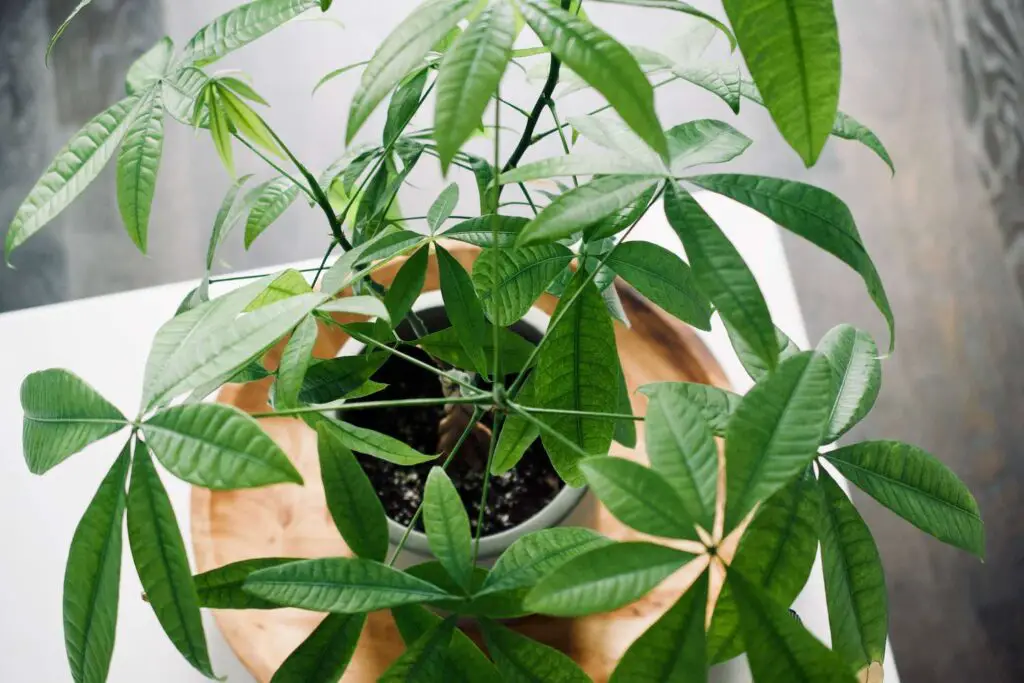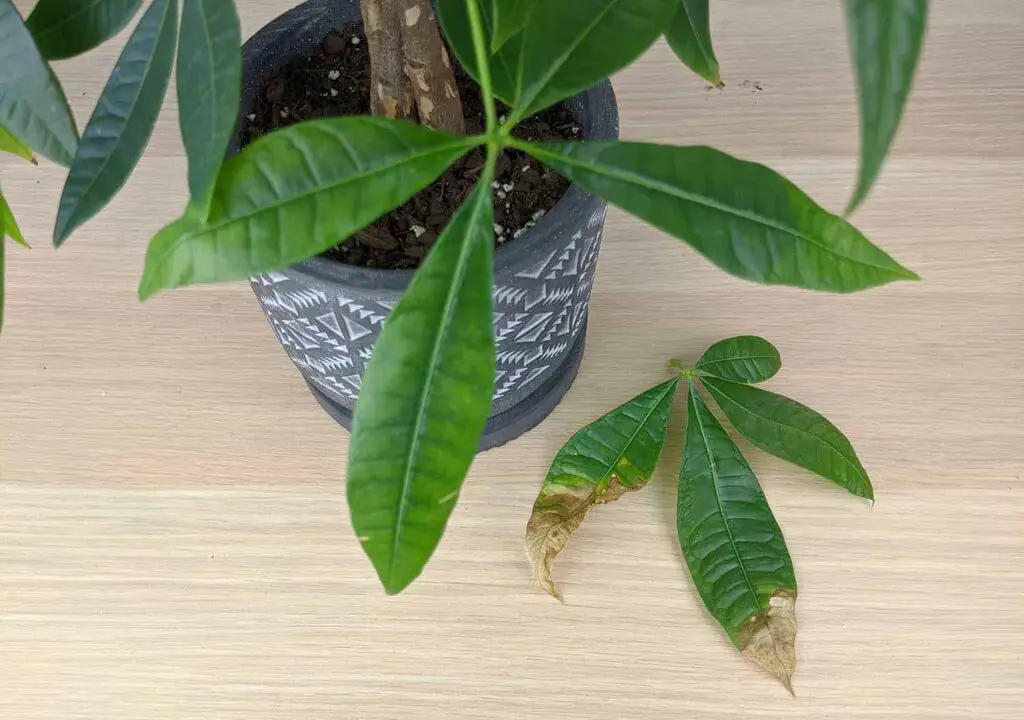An overwatered Money Tree displays yellowing leaves, wilting, and root rot. To fix it, reduce watering frequency, improve drainage, and consider repotting with fresh soil. Monitoring humidity and ensuring proper pot size are also essential for recovery.
Understanding the Money Tree
The Money Tree, scientifically known as Pachira aquatica, is a popular houseplant known for its lush green leaves and braided trunk. This tropical plant originates from Central and South America and is often associated with good luck and prosperity. Many people choose to keep a Money Tree in their homes or offices for its aesthetic appeal and symbolic value.

Despite its reputation for being a hardy plant, the Money Tree can suffer from overwatering, which is a common issue among indoor gardeners. Understanding the signs of overwatering and knowing how to address them is crucial for maintaining the health of your Money Tree. With proper care, this plant can thrive and continue to bring joy to its owners.
Signs of Overwatering
Identifying an overwatered Money Tree early can prevent further damage. Here are some key indicators to watch for:
- Yellowing Leaves: The most noticeable sign of overwatering is the yellowing of leaves. This change often starts at the bottom of the plant and gradually moves upward.
- Wilting: Overwatered plants may become limp and droopy. This occurs because the roots are suffocated and unable to absorb nutrients effectively.
- Root Rot: A more severe consequence of overwatering is root rot. This occurs when roots sit in water for too long, leading to decay.
- Foul Odor: If you notice a musty smell coming from the soil or plant, it may indicate rotting roots.
- Leaf Drop: In advanced cases, leaves may drop prematurely from the plant as it struggles to cope with excess moisture.
Recognizing these signs early on can help you take action before your Money Tree suffers permanent damage. It’s essential to regularly inspect your plant and its environment to ensure it’s thriving.

How to Fix an Overwatered Money Tree
If you notice signs of overwatering in your Money Tree, immediate action is necessary. Here are steps you can take to help your plant recover:
- Assess Watering Schedule: Check how often you have been watering your Money Tree. Typically, allowing the top inch of soil to dry out between waterings is recommended.
- Improve Drainage: Ensure that your pot has adequate drainage holes. If water cannot escape, it can lead to root rot.
- Repot if Necessary: If you suspect root rot, consider repotting your plant in fresh soil. Gently remove the plant from its pot and inspect the roots. Trim away any black or mushy parts before replanting in dry soil.
- Avoid Watering for a While: After addressing drainage issues, hold off on watering for several days to allow the soil to dry out completely.
- Monitor Humidity: Keep an eye on humidity levels in your home. Money Trees thrive in moderate humidity; excessive humidity can contribute to overwatering issues.
Additional Care Tips
To prevent future overwatering, consider implementing these care tips:
| Care Aspect | Recommendation |
|---|---|
| Watering Frequency | Water only when the top inch of soil is dry. |
| Soil Type | Use well-draining potting mix. |
| Pot Size | Choose a pot with sufficient drainage holes. |
| Humidity Levels | Maintain moderate humidity; use a humidifier if necessary. |
By following these guidelines, you can help your Money Tree flourish while avoiding the pitfalls of overwatering.

Understanding the Root System
The root system of a Money Tree plays a vital role in its overall health. Roots are responsible for nutrient uptake and water absorption. When a plant is overwatered, the roots can become waterlogged, leading to several issues. Recognizing how the roots function can help you better understand the importance of proper watering practices.
Root Health and Growth
Healthy roots are essential for your Money Tree’s growth and vitality. Here are some key points regarding root health:
- Oxygen Supply: Roots need oxygen to thrive. Overwatering can lead to anaerobic conditions, causing root suffocation.
- Root Structure: A healthy root system is typically white or light tan. Dark, mushy roots indicate rot.
- Root Growth: Well-draining soil encourages robust root development, allowing the plant to absorb nutrients effectively.
Diagnosing Root Rot
Root rot is one of the most severe consequences of overwatering. Identifying it early is crucial for saving your Money Tree. Here are common signs and diagnostic techniques:
Visual Signs of Root Rot
When checking for root rot, look for the following visual indicators:

- Mushy Roots: Healthy roots should be firm and intact. Mushy or dark roots are a sign of decay.
- Discoloration: Roots that appear brown or black often indicate rot. In contrast, healthy roots will have a lighter color.
- Foul Smell: A sour or rotting smell coming from the soil is a clear indication that root rot may be present.
Testing Soil Moisture
Before repotting or making drastic changes, testing the soil moisture can provide valuable insights into your plant’s condition. Consider the following methods:
- The Finger Test: Insert your finger into the soil up to the first knuckle. If it feels wet, wait a few days before watering again.
- Soil Moisture Meter: Using a moisture meter can help you get an accurate reading of soil moisture levels.
- Pot Weight: The weight of the pot can also indicate soil moisture. A heavier pot usually means more moisture, while a lighter pot suggests dryness.
Effective Repotting Techniques
If you suspect that your Money Tree is suffering from root rot, repotting may be necessary. Here is a step-by-step guide to repotting your plant properly:
Gather Your Materials
Before starting, ensure you have all necessary materials on hand:
- New pot with drainage holes
- Well-draining potting mix
- Pruning shears or scissors
- Trowel for transferring soil
- Watering can for aftercare
Repotting Steps
Follow these steps to repot your Money Tree effectively:
- Remove the Plant: Gently take the Money Tree out of its current pot. Be careful not to damage the roots.
- Inspect the Roots: Examine the roots closely. Trim away any damaged or mushy parts using clean pruning shears.
- Add Fresh Soil: Place a layer of fresh potting mix at the bottom of the new pot. This will provide a base for your plant.
- Position the Plant: Center the Money Tree in the new pot and fill in around it with more soil. Make sure the base of the trunk is level with the soil surface.
- Water Sparingly: After repotting, water lightly to help settle the soil but avoid soaking it.
Post-Repotting Care
After repotting, your Money Tree will need special care to recover fully. Here are some important tips:
- Avoid Direct Sunlight: Keep your plant in a shaded area for a few days to reduce stress.
- Monitor Soil Moisture: Check the soil regularly and only water when necessary.
- Provide Stability: Ensure that the plant is stable in its new pot, preventing it from tipping over.
Caring for an overwatered Money Tree requires attention and patience. By understanding root health, recognizing signs of root rot, and implementing effective repotting techniques, you can help your plant recover and thrive once again.
Preventing Overwatering in the Future
Once you have addressed the issue of overwatering and helped your Money Tree recover, it is essential to implement preventive measures. This will help ensure that your plant remains healthy and vibrant. Below are some effective strategies for preventing overwatering.
Establish a Consistent Watering Routine
Developing a consistent watering schedule is key to maintaining the health of your Money Tree. Here are some tips for establishing a routine:
- Check Soil Moisture Regularly: Always test the soil before watering. Use your finger or a moisture meter to determine if the top inch of soil is dry.
- Seasonal Adjustments: Adjust your watering frequency based on the season. Plants typically require less water in the winter than in the summer.
- Water in the Morning: Watering in the morning allows plants to absorb moisture before the heat of the day, reducing evaporation.
Choose the Right Potting Mix
The choice of potting mix can significantly affect how well your Money Tree drains water. Consider these factors when selecting soil:
- Well-Draining Soil: Use a potting mix designed for houseplants with good drainage properties. Look for mixes containing perlite or sand, which improve aeration.
- Avoid Heavy Soils: Steer clear of dense soils that retain too much moisture. Heavy soils can lead to soggy roots and promote rot.
- Custom Mixes: You can create your own mix by combining standard potting soil with perlite or orchid bark to enhance drainage.
Monitoring Environmental Conditions
Your Money Tree’s environment plays a crucial role in its health. Here are some important factors to monitor:
Light Conditions
Light exposure impacts how much water your Money Tree needs. Consider these points:
- Indirect Light: Money Trees thrive in bright, indirect light. Too much direct sunlight can cause leaves to burn, while too little can slow growth.
- Rotate the Plant: Rotating your plant can ensure even light distribution, promoting balanced growth and preventing leaning.
Humidity Levels
Humidity is another critical factor affecting your plant’s health. Follow these tips to maintain optimal humidity:
- Aim for Moderate Humidity: Money Trees prefer humidity levels between 40-60%. Use a hygrometer to measure humidity in your home.
- Use a Humidifier: If your home is dry, consider using a humidifier to maintain adequate moisture levels in the air.
- Grouping Plants: Grouping plants together can create a mini-ecosystem, increasing humidity around them.
Signs of Underwatering
While preventing overwatering is essential, it’s also crucial to recognize signs of underwatering. This can also negatively impact your Money Tree’s health. Here are signs to watch for:
- Crispy Leaves: Leaves may become dry and crispy, especially at the tips, indicating a lack of moisture.
- Leaf Drop: If leaves start dropping off suddenly, it may be a sign that the plant is not receiving enough water.
- Wilting: Unlike an overwatered plant, an underwatered Money Tree may exhibit wilting or droopiness due to insufficient moisture.
Tips for Healthy Growth
In addition to preventing overwatering, consider these tips for promoting overall health and growth in your Money Tree:
- Fertilize Appropriately: During the growing season (spring and summer), feed your Money Tree with a balanced fertilizer every four to six weeks.
- Pest Management: Regularly check for pests such as spider mites and aphids. Early detection can lead to more effective management.
- Prune Regularly: Pruning helps maintain shape and encourages new growth. Trim away any dead or yellowing leaves as needed.
By implementing these preventive measures and maintaining awareness of environmental conditions, you can ensure your Money Tree thrives while avoiding the pitfalls of overwatering and underwatering alike.
Understanding the Benefits of a Healthy Money Tree
A thriving Money Tree not only enhances the aesthetic appeal of your home or office but also offers several benefits. Understanding these advantages can motivate you to provide the best care possible for your plant.
Air Purification
One of the key benefits of having a Money Tree is its ability to purify the air. Like many indoor plants, it can absorb toxins and improve indoor air quality. Here are some points about its air-purifying abilities:
- Toxin Absorption: Money Trees can remove harmful substances such as formaldehyde and benzene from the air.
- Increased Oxygen Levels: Through photosynthesis, Money Trees release oxygen, contributing to a healthier environment.
Stress Reduction
Having plants like the Money Tree indoors can significantly reduce stress levels. Studies have shown that greenery can have a calming effect on people. Consider these aspects:
- Enhanced Mood: The presence of plants can elevate mood and promote feelings of happiness.
- Improved Focus: A green environment can increase concentration and productivity, making it ideal for workspaces.
Symbolic Meaning
The Money Tree is often associated with good luck and prosperity. Many people choose to keep this plant based on its symbolic significance:
- Wealth Attraction: According to Feng Shui, the Money Tree is believed to attract financial prosperity.
- Positive Energy: It symbolizes positive energy and growth, making it a popular gift for new beginnings.
Common Myths About Money Trees
As with many plants, there are several myths surrounding the care and significance of Money Trees. Here are some common misconceptions:
- Myth: Money Trees Require Constant Watering: This misconception leads to overwatering. In reality, allowing the soil to dry out between waterings is crucial for plant health.
- Myth: They Can Thrive in Complete Darkness: Money Trees need bright, indirect light. While they can tolerate lower light conditions, they thrive with adequate lighting.
- Myth: Money Trees Are Pet-Friendly: While they are not toxic to humans, Money Trees can cause mild irritation in pets if ingested.
Additional Resources for Care
If you’re looking to deepen your understanding of how to care for your Money Tree or other houseplants, numerous resources are available:
- Books: Consider reading books focused on houseplant care for in-depth information and tips.
- Online Communities: Join forums or social media groups where plant enthusiasts share their experiences and advice.
- YouTube Channels: Many gardening experts create video content that can visually guide you through plant care techniques.
Conclusion
Caring for a Money Tree involves understanding its specific needs, particularly when it comes to watering practices. Recognizing the signs of overwatering, such as yellowing leaves and root rot, is essential for ensuring your plant’s health. By implementing effective care strategies—including proper potting mixes, consistent watering schedules, and environmental monitoring—you can help your Money Tree thrive.
The benefits of a healthy Money Tree extend beyond its aesthetic appeal. From purifying the air to reducing stress and symbolizing good fortune, this plant offers numerous positive impacts on your living space. By dispelling common myths and utilizing available resources, you can enhance your gardening knowledge and foster a thriving indoor garden.
With patience and dedication, you can enjoy the many rewards that come with caring for a vibrant Money Tree. Embrace the journey of nurturing your plant and watch it flourish in your home or office.
